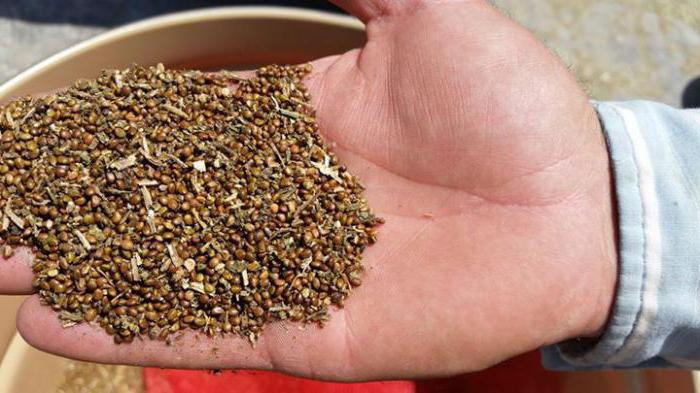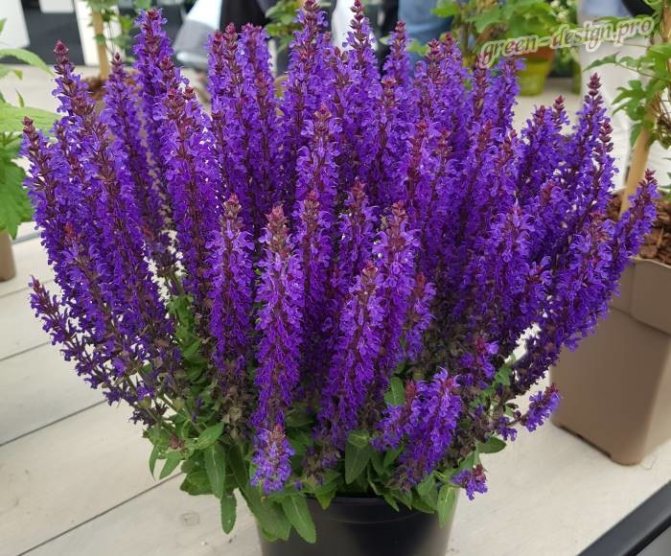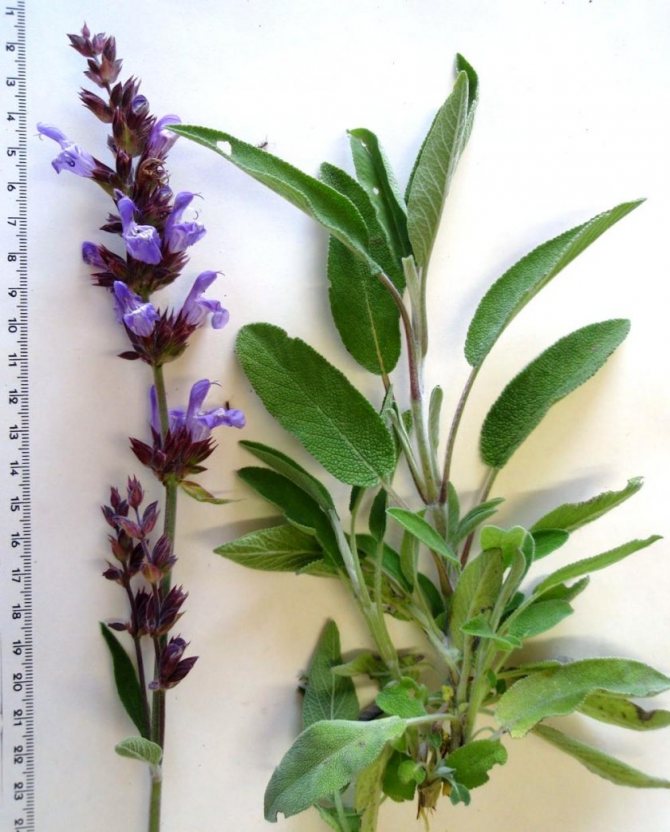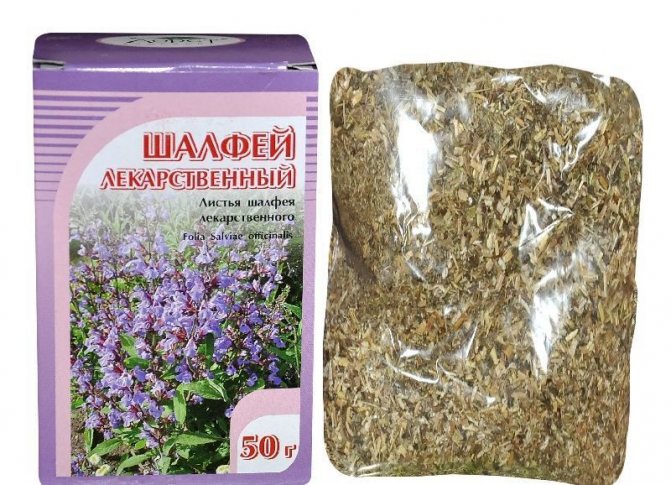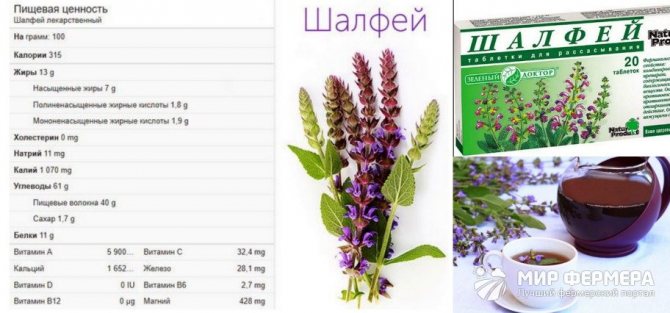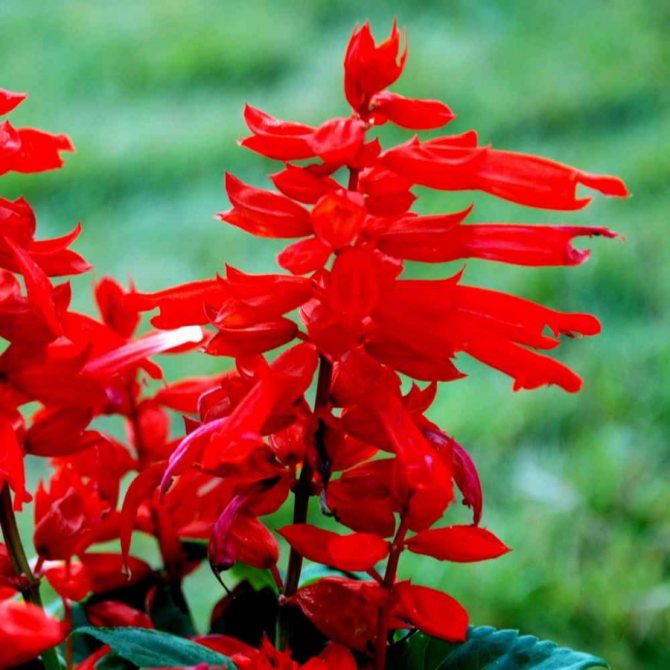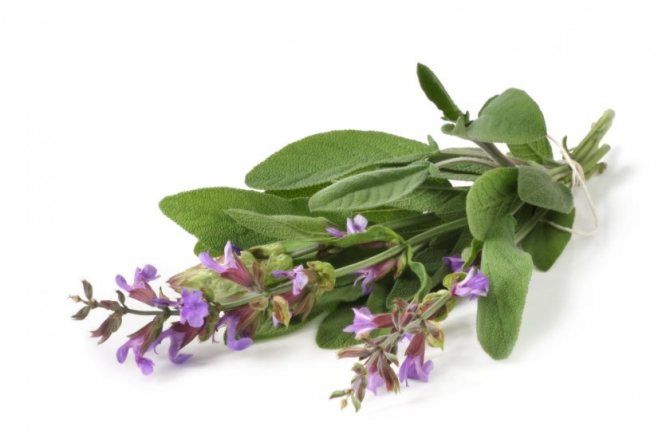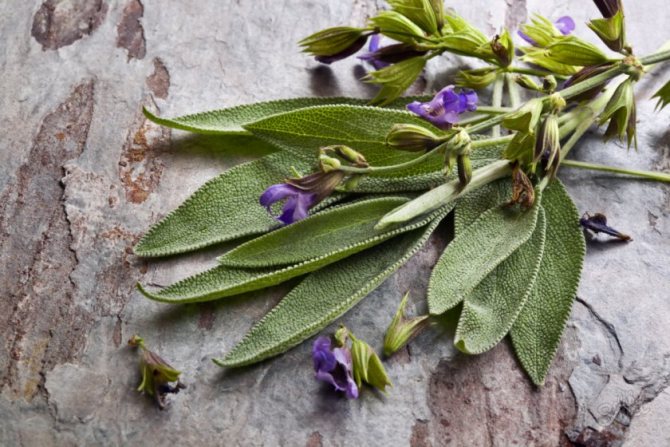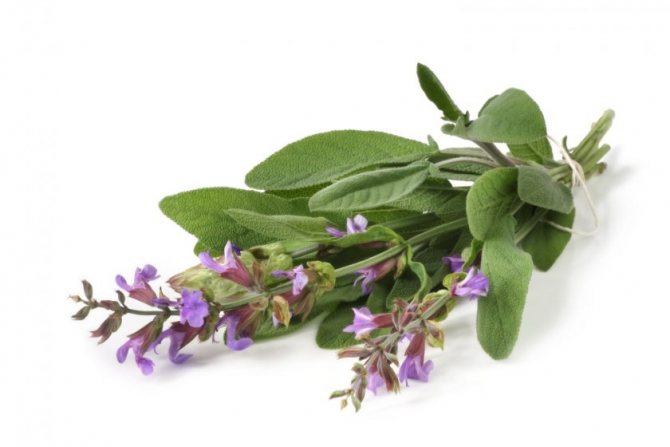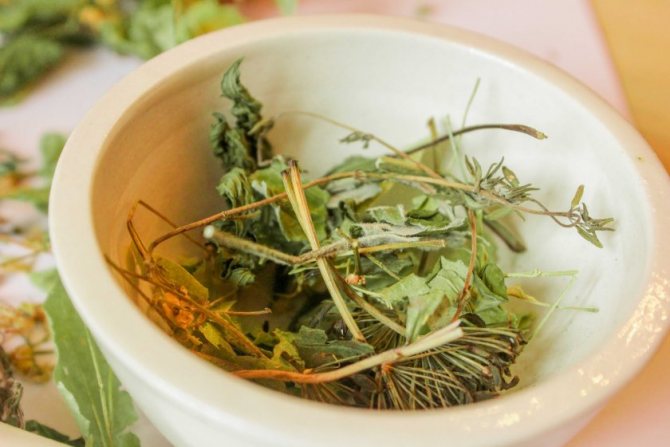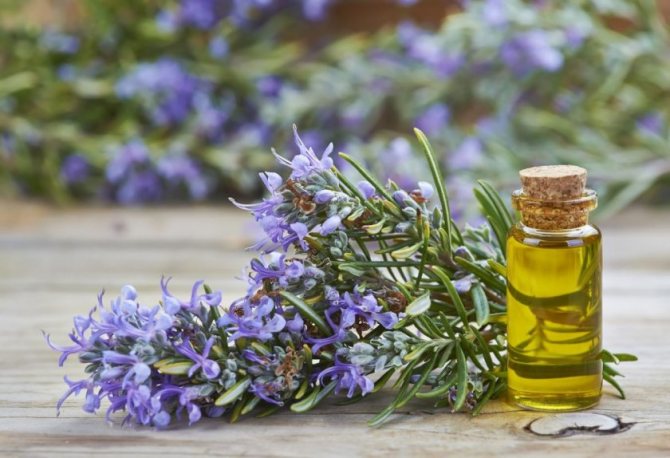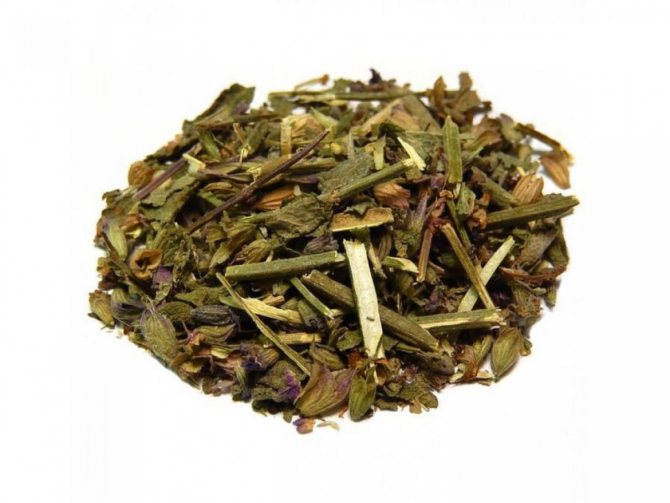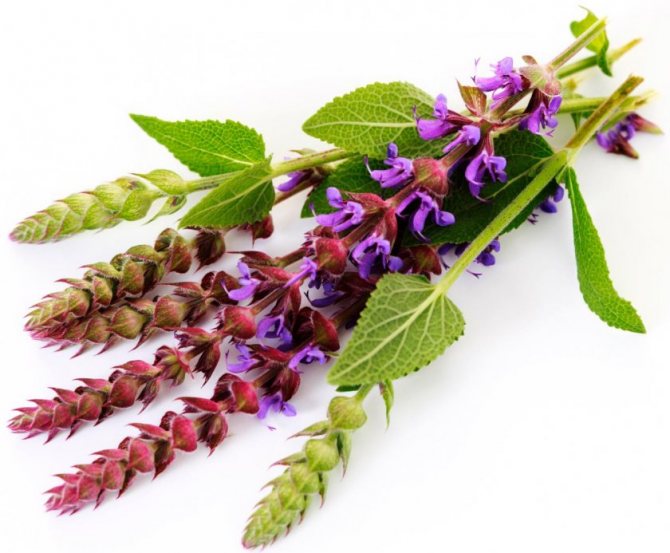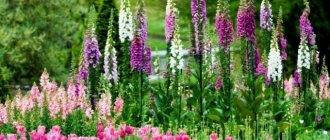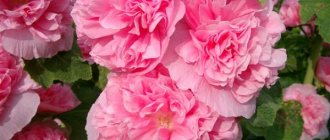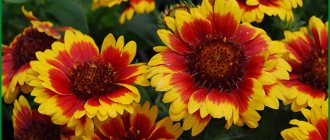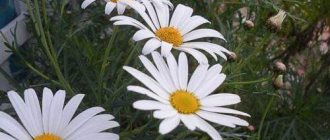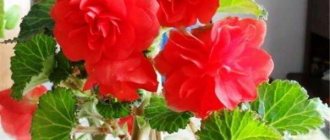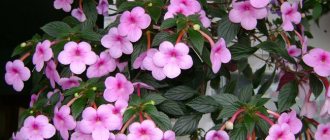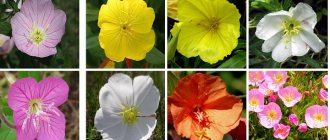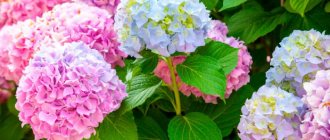Salvia is also called sage. The plant belongs to perennial herbaceous and shrubby crops of the Lamiaceae or Labiate family. You can meet them in the tropics and regions with a temperate climate. It does not grow only in Australia. Literally the name of the plant can be translated as “to be healthy”. The fact is that some varieties are used for medicinal purposes.
To prevent confusion: the medicinal flower and spice have the name sage, but the decorative representatives of this species are salvia. Having figured out what salvia is, you can move on to a variety of shrub varieties.
Varieties and varieties
The Latin name of the plant "Salvia" in the Russian interpretation means "to be healthy." Photo culture is often the hallmark of pharmaceuticals. It is a perennial herb, a shrub. Stems are tetrahedral, erect, reaching a height of 1.2 m. Shoots are densely covered with wedge-shaped leaves 4 to 8 cm long and 1 to 3 cm wide. The shape of the inflorescence is a spikelet or panicle. Small bright flowers bloom in mid-July and bloom until late autumn.
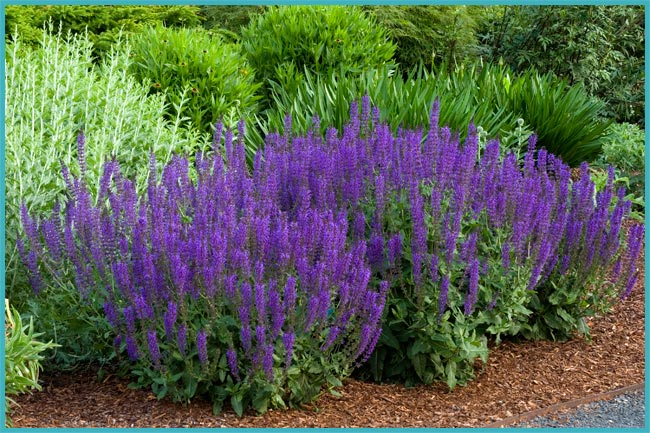
Sage is not only a beautiful but also a very useful plant.
The most common types are:
Salvia officinalis (S.officinalis) is a plant reaching a height of 20-70 cm. The leaves are elongated, narrow (0.8-1.5 cm), densely pubescent, gray-green in color, the stem is covered with whitish villi. It is widely used in cooking, medicine and cosmetology. Varieties:
- Breeze is a semi-shrub up to 60 cm high with jagged leaves and blue-blue flowers;
- Aibolit is a tall plant (up to 120 cm), distinguished by wrinkled dark green foliage with a strong edge;
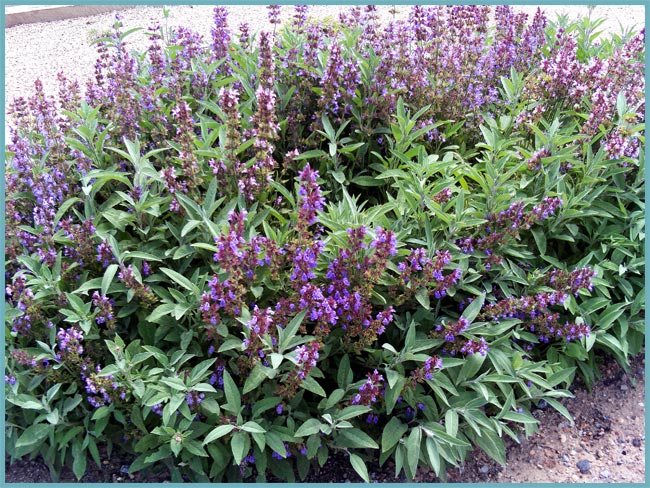

Salvia officinalis
- Nectar is a medium-sized bush, reaching 1 m in height. Leaves are light green, strongly pubescent. Spike-shaped inflorescences are strewn with purple or blue flowers;
- Semko Patriarshy is a low plant (50-70 cm) with long (up to 10 cm) leaves that densely cover the stalk stiff from below.
Forest sage (oak, wild - S. nemorosa) is a spice plant found on the edges of forests and on hillsides in the Mediterranean countries. The stem is herbaceous, the leaves are narrow, lanceolate. The flowers are collected in spike-shaped inflorescences of the violet or blue spectrum. Varieties:
- undersized - Plumosa, Blue and Pink Queen, Marcus - reach a height of 25 to 50 cm, bloom with pink, purple, blue and purple flowers;


Forest sage
- tall - Adrian, Caradonna, Mainacht, Ametist - peduncles reach a height of up to 90 cm, dense spike-shaped inflorescences convey a wide range of colors - from white-pink delicate shades to deep violet-blue.
Meadow sage (S.pratensis) and Clary sage (S.glutinosa) is a species of oak sage. Sh. Sticky deserves attention because of the unusual greenish-yellow color of the leaves. Interesting photos, where lush paniculate inflorescences of a pale yellow color create a delicate background for brighter flowers.
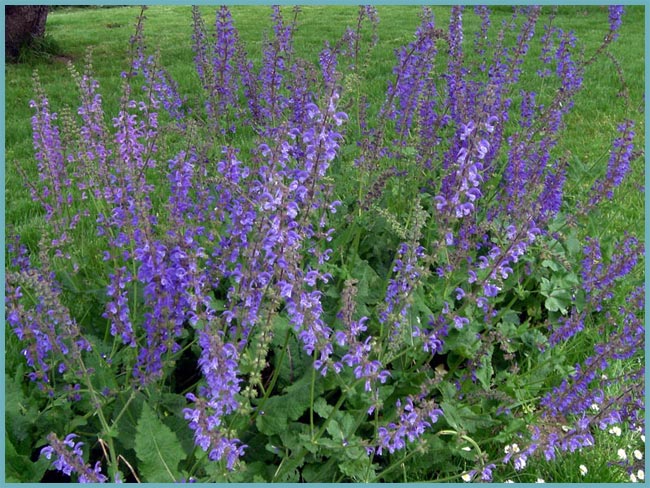

Meadow sage
Salvia sparkling: photo of flowers Salvia splendens
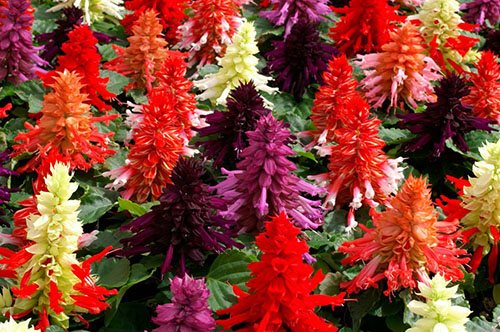

The most famous of the garden species of Salvia is a native of Brazil, used in culture for almost 200 years.At home, bushes or herbaceous plants with hard erect tetrahedral stems can reach 20–80 cm in height and bloom en masse during the summer and autumn.
Before the start of active breeding work, brushes of brilliant Salvia, the photos of flowers of which today amaze with the richness of colors and splendor of inflorescences, were not so spectacular. At the disposal of gardeners were only varieties with red corollas and cups, loosely sitting on the peduncle.
Today, in addition to red flowers, one can increasingly find brilliant white, purple lilac and even two-tone salvia.
Planting a plant
Different types of sage are ambiguous about equal conditions. Oak and meadow prefer sunny areas and moderate watering. These are drought-resistant plants for which waterlogging is dangerous. Clary sage naturally lives on the edges of the forest, so light shade and moist soil are of the highest priority for it.
Despite the differences, there are general requirements:
- salvias grow more readily on light sandy loam soils;
- prefer humus-rich soil of normal acidity (pH = 6.5);
- require shelter for the winter;
- need spring pruning.
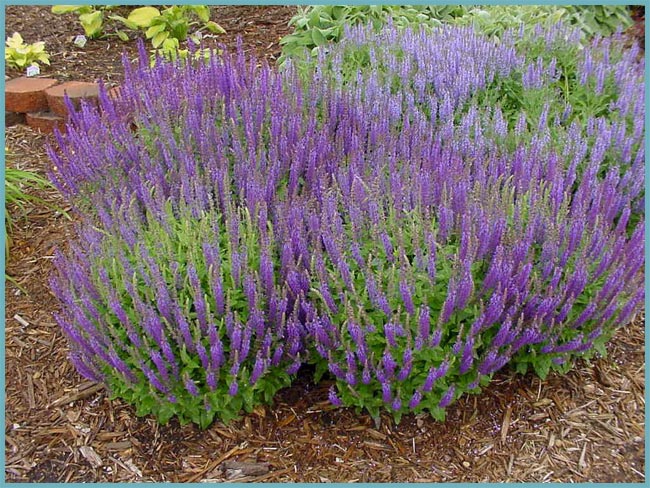

Sage is very thermophilic, so it needs to be covered well for the winter.
Since sage is a thermophilic plant, some perennial species are grown as one or two years in regions with harsh winters.
Important! Sage is a cross-pollinated plant, therefore, to preserve species characteristics, different varieties are planted at some distance.
Salvia's pick
As soon as the first leaves appear on the flowers, they can be planted in separate containers or pots. Timely care is very important here. Young plants can be grown in the same soil that was used for sowing seedlings. After planting in separate containers, the salvia must be well watered and covered with paper for 2-3 days. After the appearance of several leaves, it is recommended to pinch the salvia, resulting in a beautiful plant with a dense crown.
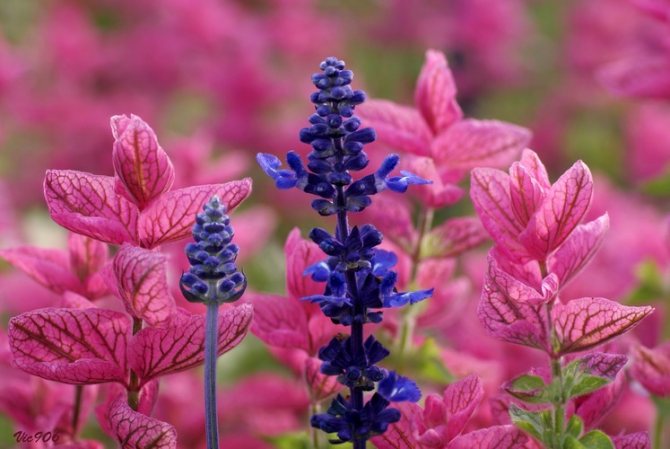

Plant care
The plant is quite unpretentious - care consists in removing weeds and loosening the soil. For the winter, even the most frost-resistant species are covered with fallen leaves. In early spring, old shoots are cut, leaving about 10 cm from the root, the rosette is mulched with cut grass or peat. Watered very carefully, avoiding stagnant water. Often in the photo you can see such a landscape design technique as gravel mulching. This method is also acceptable for sage.
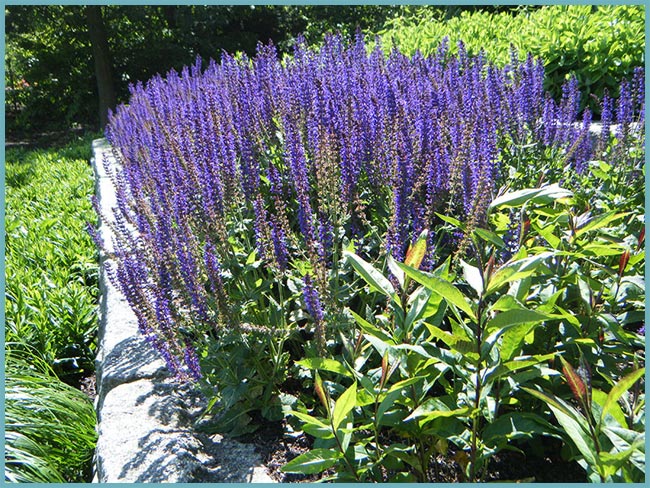

Mulch the soil, this will help the crop retain the necessary moisture
Small-leaved salvia (Salvia microphylla)
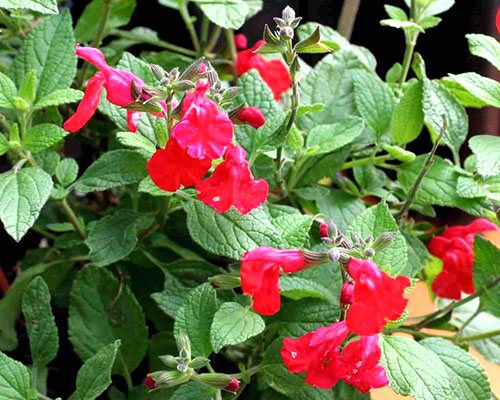

This species of salvia - sage in the wild is still found in southern Europe, France and the Mediterranean countries. Here it is a perennial evergreen plant, it grows up to 100–120 cm. Salvia bloom continues from June to the end of October.
But small brushes of carmine flowers are not the only characteristic feature of the species. The greens and stems of the evergreen shrub contain many aromatic essential oils used by perfumers and doctors.
Fertilization and feeding
The correct development of sage is ensured by timely feeding:
- at the beginning of shoot formation, the plant perfectly accepts nitrogen fertilizers (for example, slurry in a ratio of 1: 10);
- during the period of bud formation - complex mineral fertilizers containing potassium and phosphorus (at the rate of 15-20 g per m2).


To feed sage you need mineral fertilizers
Fertilize the soil before planting a plant by introducing organic fertilizers (0.5-1 kg) in the wells in combination with mineral fertilizers (3-5 g).
Important! When planting sage, only rotted manure is used.
Seedling preparation
Salvia sage prefers fertile light soils.If the soil lacks organic matter or is clayey, then the plants will have scanty peduncles without bright colors. Store-bought potting mix is ideal for seedlings. Some gardeners make their own soil by mixing the following ingredients:
- garden land;
- peat;
- washed sand.
Multi-tiered bow - planting and care
All parts are taken in equal quantities.
An important point. Before starting planting, the prepared soil is heated in the oven, which helps to destroy harmful spores and weed seeds.
Salvia has very small seeds and is often sold as granules. This greatly facilitates the sowing work, moreover, there are substances useful for the sprouts in the granules, but due to the action of the shell, their germination will slow down a little. This point should be taken into account when growing seedlings for sale.
In the containers chosen for planting, you need to pour expanded clay or small pebbles that act as a drainage system. On top is the soil layer. It is recommended to leave 2 cm of free space up to the edges of the sides.


Seedling
The soil is properly moistened, after which the seed can be planted. After sowing, you need to press down the seeds a little and sprinkle with earth a few millimeters. A spray bottle is used to moisten the crops.
After disembarkation, the containers with earth are covered with film or glass and placed in a warm room, out of reach from the rays of the sun. Before the first shoots appear, it is necessary to maintain a temperature regime of about + 22-25 ° C. Seedlings begin to appear 15-30 days after sowing. It all depends on the variety.
What to do when shoots appear
Growing salvia from seeds involves caring for the seedlings. After the plants begin to appear en masse, the containers are rearranged in a bright place, because the seedlings need at least 12 hours of daylight. If necessary, you need to organize the lighting in the morning and evening Lack of lighting negatively affects the growth of seedlings.


Seedlings appear
The soil must be regularly moistened, but it is important not to overdo it. Covering material is removed for a short period of time for ventilation. During this time, the plants develop an environment with optimal humidity. Watering is carried out using a spray. Alternatively, you can pour water into trays, from where it is absorbed into the soil layer. Excess liquid leads to rotting of the bases of the sprouts.
After the picking, the plants are gradually hardened, taking them out for 10 minutes in a cool place.
It's worth knowing. If rotting could not be avoided, then the covering material must be removed from the boxes, and the upper earthen layer is sprinkled with a small amount of wood ash.
Landing in a permanent place
In order for salvinia sage to always bloom profusely, it is necessary to choose the right place in the garden. Most species require a sunny area, and only a few are suitable for partial shade. The soil should be well fertilized, allow moisture to pass through, and have a lime impurity. Light sandy soil, also suitable for this crop.
The salvia flower is planted in late May or early June. At this time, there are no night frosts. In most cases, the seedlings adapt perfectly to the new location.


Planting from seedlings
The planting hole should not be deep, but make it based on the size of the roots of the system. Before planting, a small amount of a mixture of soil with humus is poured onto the bottom of the hole. It remains to lower the seedlings into the ground, spread the roots, fill in the soil and compact it. Watering with warm water ends the work.
How to care
Taking care of the plant is as easy as taking care of everyone else. Salvia needs watering, weeding, soil loosening, fertilization.These actions are carried out as needed.
Watering is organized in such a way that the earth dries out properly after the previous watering. It is recommended to take a watering can in the evening, but it is important not to overdo it, because the culture reacts negatively to moisture stagnation in the root system. After watering, after a short time, the soil must be loosened and weeds must be removed if they begin to break through.
Complex mineral fertilizers are applied in the summer at least twice:
- for the first time a weak solution with fertilizers is used to feed seedlings;
- fertilize the second time when buds begin to form.
Flowering problems
Some gardeners ask the question why salvia does not bloom? This happens due to the fact that the plant has a long growing season, and therefore it is necessary to observe the timing of planting seed material to obtain seedlings.
Reproduction of sage
Propagated in three ways:
- vegetatively - lignified cuttings;
- seeds and seedlings;
- dividing the bush or layering.
To obtain seedlings, seeds are sown in prepared containers in February-March. The first shoots appear in 1.5-2 weeks, and in the third week after planting, the seedlings dive into peat pots. In warm areas, already in April, seeds can be planted directly into open ground or used for winter planting. For spring sowing, the seeds are pre-soaked in a growth stimulator; in the fall, only dry seeds are embedded in the soil. The distance between the grooves is 15-20 cm, the depth is 4 cm.


The easiest way to propagate sage is by cuttings.
Cuttings are carried out at any time. For this, semi-lignified shoots are cut into 15 cm long pieces and rooted in a vessel with water. New roots appear within 2 weeks.
The pivotal root system of sage has the ability to form well-developed adventitious processes, so in late summer or early autumn, the bush can be planted painlessly.
Propagation of salvia by air layering
Salvia can also be propagated with an air layer. To do this, it is enough to press the branch to the ground, strengthening it with a metal bracket, and after a few months, you can notice the appearance of new roots on the layer. After the roots are formed on the cut, the root can be carefully cut off from the "parent" bush and planted in another place.
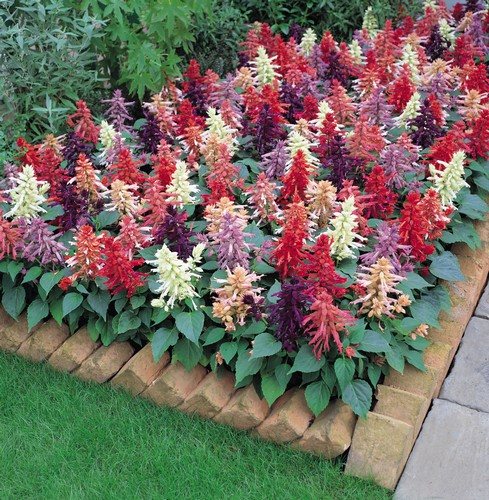

Diseases and pests of sage
Since sage belongs to the group of herbal medicinal plants, in itself it is an excellent insecticide, resistant to diseases and pests. With over-watering, there is a danger of mildew (mold) damage, so the soil around the plant should be slightly moist, but not waterlogged. Spraying with a sulfur solution is a good remedy for mold. Pests rarely disturb the plant, but with thickened plantings, slugs, spider mites and thrips may appear.


Of the pests, sage is most often overcome by slugs.
Diseased plants are treated with tinctures of garlic, onion peels in combination with a solution of laundry soap.
Traditional methods of pest control
- Finely chop two heads of garlic, pour in a liter of water and leave for 5-7 days in a dark place. Dilute 1: 1 with water, add 3-5 g of laundry soap, and spray the plants.
- For 100 g of onion husks steamed in 5 liters of water, take 10 g of soap, spray immediately after cooling.
What helps
The range of exploitation is wide: from superficial injuries, mechanical damage to serious diseases.
Diseases
Sage-containing products are indicated for:
- diseases of the mouth, throat (toothache, stomatitis, tonsillitis);
- problems with the gastrointestinal tract (ulcer, gastritis);
- diseases of the respiratory system (bronchitis, pneumonia);
- colds;
- hemorrhoids;
- the initial stage of diabetes mellitus;
- skin rashes (dermatitis, acne, psoriasis);
- cuts, frostbite, burns;
- reduced immunity;
- chronic fatigue;
- menopause;
- infertility.
With a strong cough, a glass of milk, boiled for five minutes with a teaspoon of the herb, will help. The slightly cooled drink is drunk in small sips at a time.
Slimming
Due to several properties at once, sage is recommended for getting rid of excess weight. It dulls the feeling of hunger, while energizing, removing toxins, blocking free radicals, speeding up metabolism, regulating stool, relieving flatulence, and helping to reduce cellulite.
Dried or fresh plants are seasoned with diet food, smoothies. But a more tangible result will be from the broth drunk on the course (no longer than 3 months in a row).
To do this, pour a tablespoon of dry collection or a handful of fresh leaves with a glass (250 ml) of clean water, heat for 15 minutes in a water bath. Then leave for another 20 minutes under the lid, strain. Drink half a glass before main meals. It is allowed to occasionally diversify the drink with a slice of lemon, honey, a slice of ginger. Before as for a long time accept sage "elixir", it is advisable to consult a doctor.
Now you know which benefit and at times harm may bring Salvia officinalis.
Shrub sage: combination with other plants
Light airy spikelets of sage go well with large heads of noble flowers. The wide blue-violet palette creates a gorgeous backdrop for warm shades of reds, yellows and oranges.


Sage in a common flower bed
Examples:
- the combination of sage with chrysanthemums, roses, lilies is used in the design of classic gardens;
- bulbous - irises, daylilies, tulips, hyacinths in the company with sage will add charm to the alpine hills;
- for landscape design in a rustic style, varieties of oak sage in combination with cereals and herbs are irreplaceable.
Salvia officinalis (Salvia officinalis)
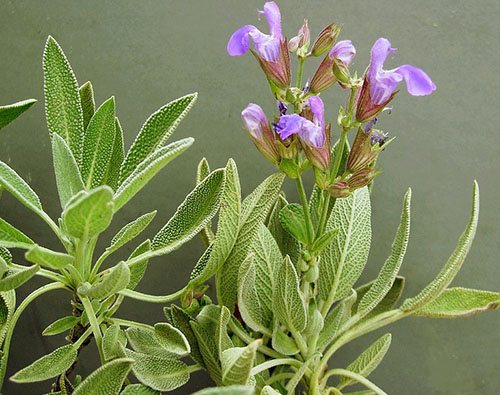

Medicinal salvia - sage, well known to people for thousands of years, is used in medicine, perfumery and cooking. The homeland of the plant is the Mediterranean state and the region of Asia Minor. Under favorable conditions, the perennial dwarf shrub reaches half a meter in height, and in Russia it can be grown only through seedlings as an annual crop.
Sage is easily distinguished by its elongated silvery leaves and purple flowers gathered in sparse vertical inflorescences.
A medicinal species of Salvia and garden varieties with variegated leaves, bloom in the height of summer.
Shrub sage in landscape design
One- or two-year-old hybrid varieties of sage, such as brilliant salvia or clary sage, are most often used in garden design. Nevertheless, perennials are often used to create mixborders, flower beds, flower beds.
A common use of perennial sage is to create a spice garden or aroma garden. A classic example of Salvia's neighbors on such an island:
- peppermint and apple;
- creeping thyme (thyme) and lemon;
- oregano and hyssop;
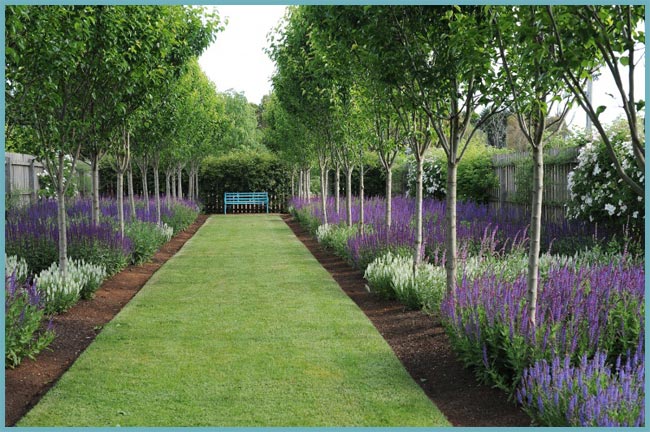

Sage in landscape design
- basil and rosemary;
- parsley and cucumber herb;
- chives and leeks.
Practical use of sage has earned him the fame of a garden healer. Essential oils and a varied composition of trace elements help in the treatment of lung diseases. In aromatherapy, sage is considered one of the most powerful sedatives. The plant is widely used in cooking as a spice. Growing perennial species in the garden guarantees health and good mood.
Medicinal properties and contraindications
After salvia, both positive and negative dynamics can be observed. It is worth refusing sage-containing preparations, infusions and other forms for pregnant women, nursing mothers, people with thyroid diseases, hypotensive patients, epileptics.In a healthy person, their excessive use becomes the cause of intoxication, which causes nausea, weakness, and migraines. Therefore, you must adhere to instructions for use.
More about useful characteristics.
Sage leaves
Pharmacy grade leaves:
- restore protective functions;
- relieve insomnia;
- increase resistance to stress;
- stimulate expectoration of phlegm;
- improve peristalsis, remove bile;
- relieve influenza intoxication.
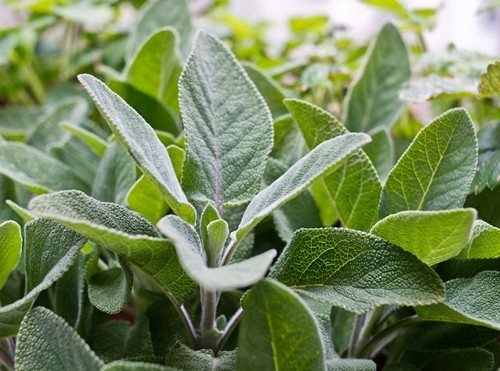

Improves immunity
Indications for outward application are wounds, burns, foci of frostbite, acne, throat congestion, baldness.
Traditionally, for a decoction, a mixture of a tablespoon of dried chopped herbs and 250 milliliters of pure water is kept for 15 minutes in a water bath. Cool, filter, add boiled water if necessary to restore the original volume of liquid. Store no longer than 12 hours.
Sage herb
In addition to the previous section, blooming mead:
- stabilizes nervous activity;
- increases efficiency, concentration;
- removes toxins, heals the digestive organs;
- stops bleeding.
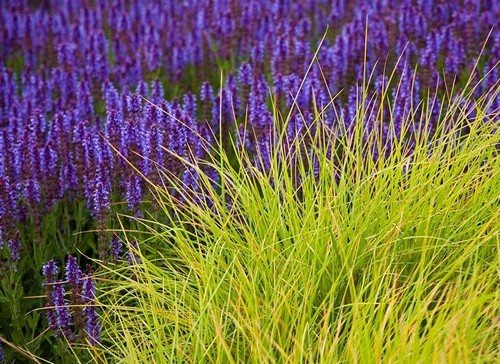

Helps Relieve Constipation and Indigestion
Decoction rinses reduce inflammation of the gums, relieve toothache.
For men
Beneficial features salvias for men's health:
- stimulates the production of testosterone;
- makes sperm more mobile, viable;
- resists infertility;
- enhances the effect of drugs that stimulate conception;
- supports the functioning of the prostate gland;
- eliminates the effects of stress, overwork;
- enhances potency, promotes sexual desire.
Is it possible men drink infusion of sage leaves constantly? No, continuous use should not exceed a month, then a three-week break should be made.
For women
Due to phytoestrogens, similar in structure to female hormones, salvia:
- stabilizes hormones;
- helps to better endure menopausal hot flashes;
- eliminates frigidity;
- reduces the level of irritability, relieves mood swings;
- relieves gynecological inflammation;
- increases the likelihood of conception.
Salvia will also help when a nursing mother needs to stop lactation. After individual selection, tea, ordinary or alcoholic infusion, extract, pharmacological tablets are used in dosage.
For kids
For children, sage preparations are usually prescribed for lesions of the gums, oral mucosa, and sore throat. They have an anti-inflammatory effect, inhibit pathogenic bacteria, and relieve coughs. Ingestion, inhalation, baths are practiced. The latter are permissible for infants, when it is required to accelerate the healing of the umbilical zone, eliminate prickly heat, diathesis, and normalize the baby's sleep.
Blooming sage: photo
Salvia motley (Salvia viridis)
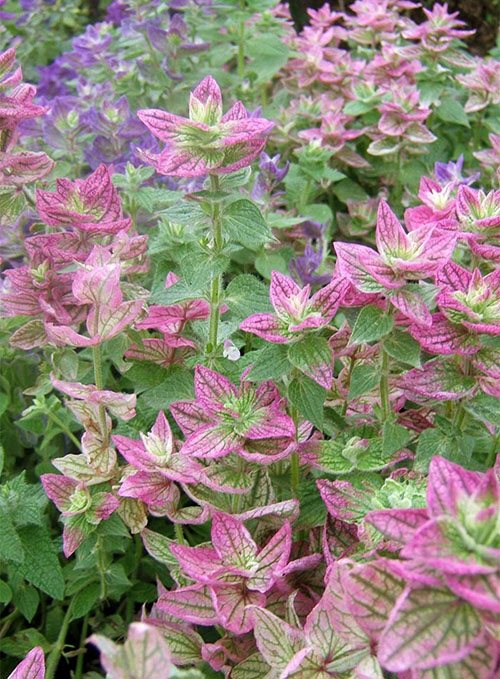

The value of this native of the south of Europe and Asia is not in bright inflorescences or essential oils, but in variegated brightly colored leaves-bracts on the upper part of 40- or 60-centimeter stems. Oblong leaves and shoots are pubescent.
Inflorescences reach 30 cm and combine up to 6 medium-sized flowers of a pinkish or light lilac shade. Salvia or sage begins to bloom in June, and the appearance of the plant remains throughout the growing season. The only feature that makes it difficult to use variegated forms in culture is lodging of the stems, if supports are not installed in time.
Salvia verticillata (Salvia verticillata)
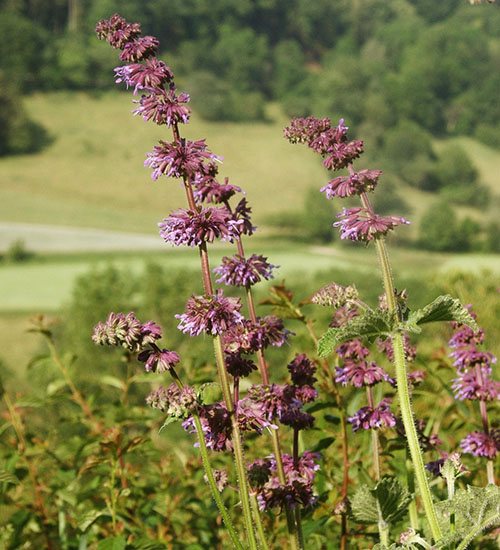

The whorled species of sage in its wild form is found throughout Russia, in Western Europe and some regions of Asia. You can recognize the few varieties of Salvia by the purple flowers collected in dense whorls located on high peduncles. Stems of this species branch only at the base and grow up to 50 cm in height.The leaves, like the shoots, are heavily pubescent and are attached to the stems on long petioles.
Whorled salvia begins to bloom in July, and until September, its elegant inflorescences can be seen in forest glades and personal plots.
Clary sage (Salvia sclarea)
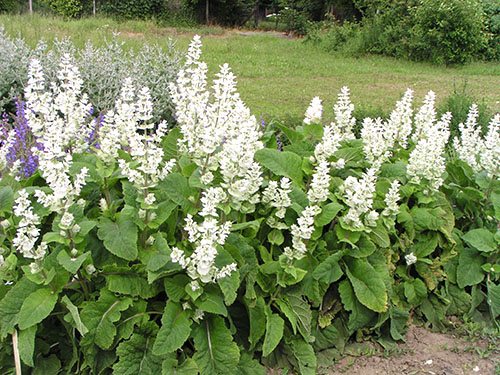

Vigorous plants of one meter in height are grown in annual or biennial crops. On straight stems, studded with oblong, jagged leaves along the edges. This type of salvia produces an abundant green mass. Leaves sometimes reach a length of 30 cm, but as they move towards the inflorescence they become smaller.
The decorativeness of the plant is given not by ordinary-looking flowers, but by the leaves-bracts. Today there are varieties of Salvia with white, pink or purple corollas. Blooming from June to September, the sage species is well known as a valuable medicinal and essential oil plant.
Side effects
- Like any medicine, sage has a number of contraindications:
- Individual intolerance. Essential components, resins, plant enzymes can cause an allergic reaction in the form of a rash, spasms.
- Asthma, severe chest cough. Reception of sage is possible only after consultation with the attending physician, the herb can cause an attack of suffocation.
- Acute forms of genitourinary diseases, urolithiasis.
- Dysfunction of the thyroid gland, sage stimulates the work of the organs of internal secretion.
- Diarrhea. When dehydrated, sage's diuretic effect is undesirable.
Spread
Naturally, various types of sage grow in tropical and temperate regions of almost the entire world. The only exceptions are Australia and the Far North. In America alone, there are about five hundred species of sage. Photos of the plant can be seen in all reference books and manuals for naturalists.
Under natural conditions, the plant prefers sunny places - rocky slopes, light forests, flooded and dry meadows, wastelands.


Beneficial features
The essential oil contained in the plant has antimicrobial and anti-inflammatory effect. It has antifungal activity and stimulates the glands in the digestive tract. Volatile phytoncides destroy bacteria, fungi and protozoa, quickly suppressing the growth of their colonies. Even the tubercle bacillus is not resistant to the phytoncides of this herb. In terms of its effectiveness, salvia essential oil is equated to Vishnevsky's ointment.
Urosolic acid has a pronounced anti-inflammatory, antitumor and antimicrobial effect. Anti-inflammatory properties are also due to the presence in its composition of tannins, flavonoid compounds and vitamin P. These substances increase the density of epithelial tissues, in addition, reduce the permeability of cell membranes, walls of lymphatic and blood vessels.
Growing salvia from seeds
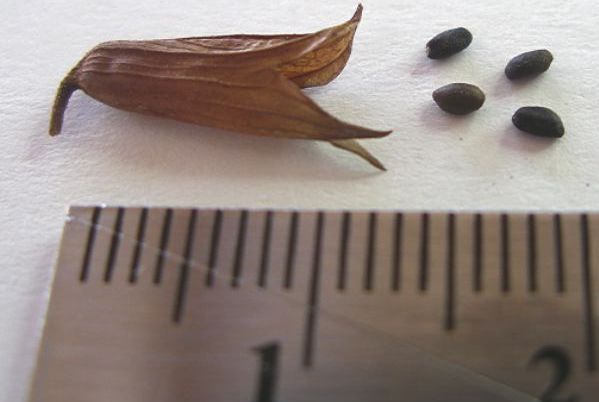

Soil for a flower can be purchased at a store or prepared independently from turf, sand and peat (2: 1: 2).
For all varieties of salvia, the soil must contain lime.
Before sowing the plants, the soil is disinfected with a hot solution of potassium permanganate. Drainage is poured at the bottom of the seedling container.
- Ordinary seeds are mixed with sand and sown in rows to a depth of no more than 2 mm.
- The granulated seeds are placed with tweezers in a 3 * 3 pattern, then lightly sprinkled with earth.
Then the surface of the seedling container is sprayed from a spray bottle and covered with a film or thick paper. The temperature of the room in which the containers will be located should not be lower than 25 degrees.
So that the earth in the mini-greenhouse does not dry out, water is poured into a pallet or sprayed with a spray bottle.
After germination
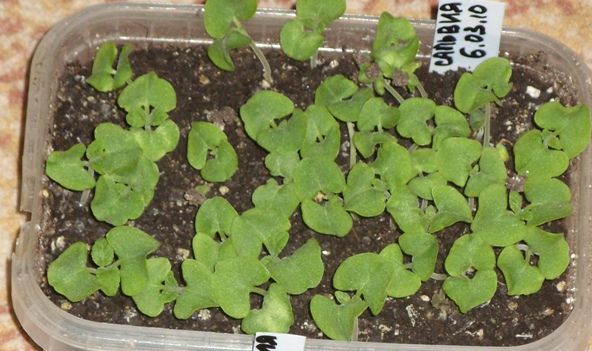

Seedlings appear after a 1-2 week interval, from granular seeds - a little later.
If you planted salvia for seedlings in February, be sure to arrange additional lighting.Daylight hours for a flower should be at least 12 hours.
Temperature range:
- in the afternoon - 25ºC,
- at night - up to 20ºC.
Picking
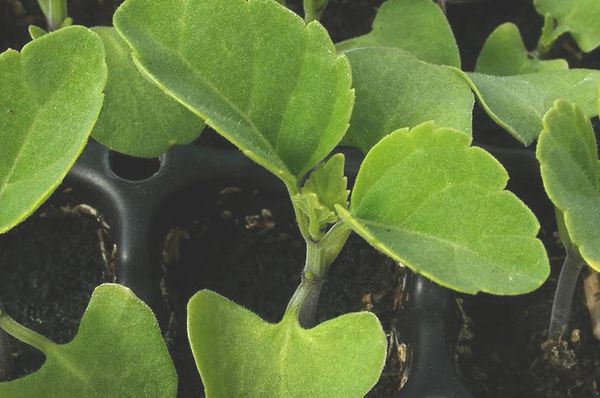

The first pair of true leaves
To strengthen the root system, the plant is dived twice. The first pick is carried out when the first 2-3 true leaves appear on the seedlings.
The soil is used the same as for sowing. Seedlings are planted in a box according to the 5 * 5 scheme, deepening the cotyledon leaf, or immediately in separate cups.
If you are doing an intermediate transplant, then after 20 days you will need to transplant salvia into separate pots 10-12 cm in diameter.
At the stage of 3-4 true leaves, it is useful to pinch the tops of the flower - it will help the formation of a bush.
From April, seedlings begin to harden, for this at night the temperature is lowered to 10 degrees.
Origin story
"Salvus" is translated as healthy, and in Latin it has a well-known name - sage. Are you surprised? Widespread as wild thickets everywhere except Australia. The benefit of the flower lies in its medicinal use in medicine.
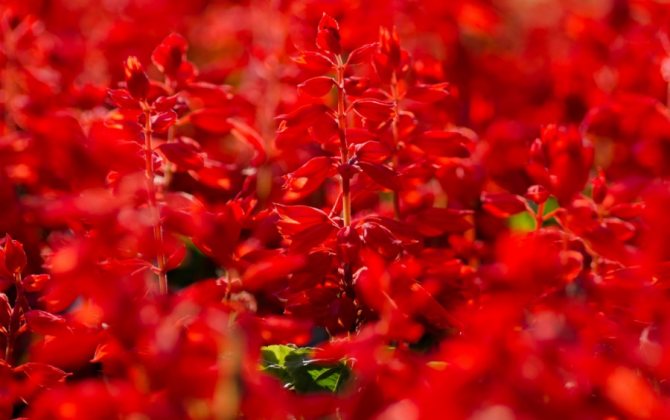

Decorative salvia does not have the desired properties and cannot be used for medicinal purposes.
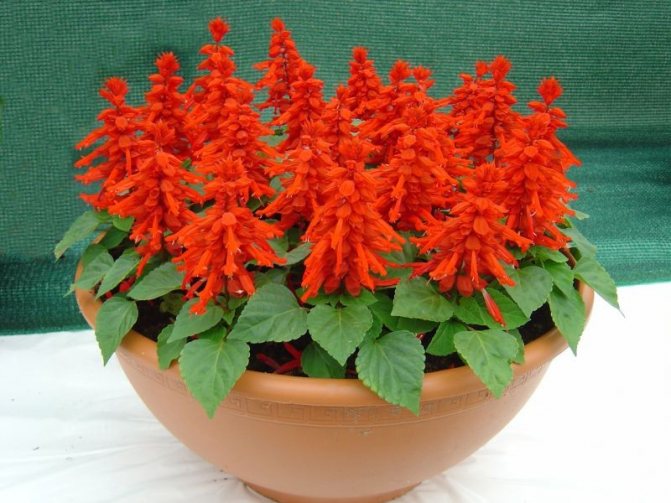

Homeland - America and Eurasia, and as a medicine, it was used in ancient Egypt for cosmetic procedures, to improve the reproductive function of the female, and it was believed that he was able to prolong life.
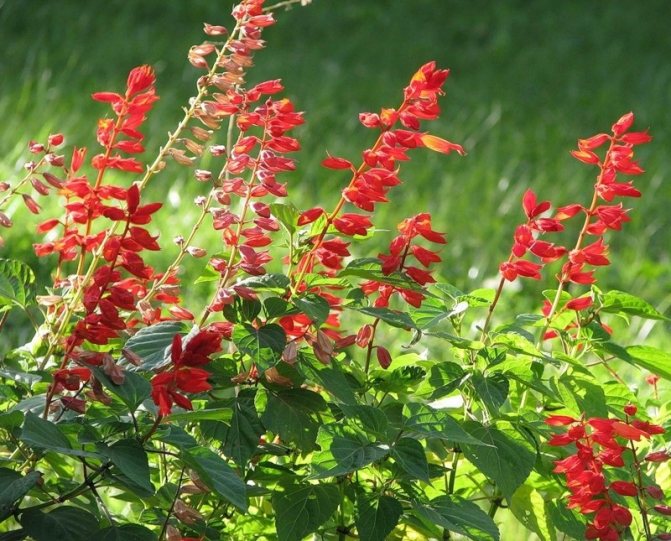

We grow in the garden
There are several ways to grow sage in the garden:
- By dividing the bush. Separate the most abundantly flowering twigs from the bush and plant on seedlings.
- With the help of seedlings. Sage seeds are kept for about a day in a wet cloth, then planted in peat pots. The plant is kept in pots before direct transplanting into the ground.
- Sowing seeds into the ground. A path is laid in the grooves from germinated seeds into a well-watered soil.
Sage is very fond of light, so it is worth choosing an area in the garden with sufficient sunlight. Not a whimsical plant does not require special soil, it is enough to choose a piece of land with fertile and sufficiently moist soil. It is not difficult to care for sage in the garden; it is enough to occasionally weed and loosen the ground. Sage can be grown in the same place for about 7-8 years. With abundant snow cover, the plant easily tolerates wintering.
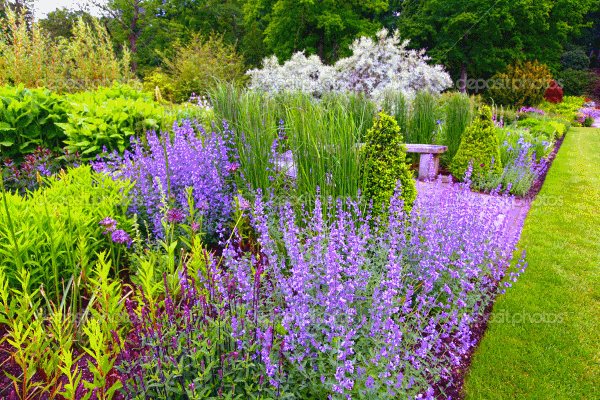

Flower in the garden
Culinary use
Common medicinal sage has a long history of culinary use. It is best to use fresh, whole or shredded leaves, after which they can be dried very easily. In order to dry the leaves, you need to cut off the flowers and then harvest a new crop, which appears after a few weeks. Be careful not to harvest old crops and also make sure you shake off dew and damp. Hang them upside down in small groups of leaves in a dry, dark place until crisp. Collect the leaves whole if possible, but in principle it does not matter, even if they break. If you make sure they are stored in a dark, airtight container, they will hold the scent for several months.
Dried herb
They will be ideal for use in traditional ground chicken or other meats such as pork and sausages. Sage is also used in vinegar and as a garnish for salads, cheeses, and butter.
There are several varieties of common garden sage, one of which is medicinal, which can be used in cooking. In addition, there are also at least four other species used for culinary purposes.
general characteristics
A powerful, strong and developed root system, overgrown with additional roots, which contributes to such a high level of survival in bad weather conditions.
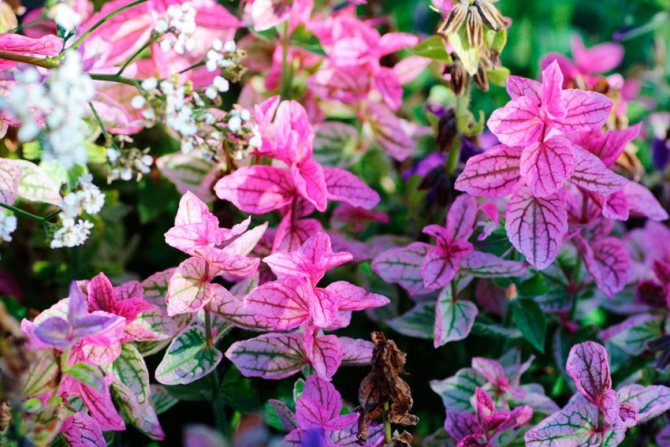

Important to remember! In the conditions of our country, it is cultivated as an annual or biennial plant, since it is influenced by frost, as a result of which it simply freezes out.
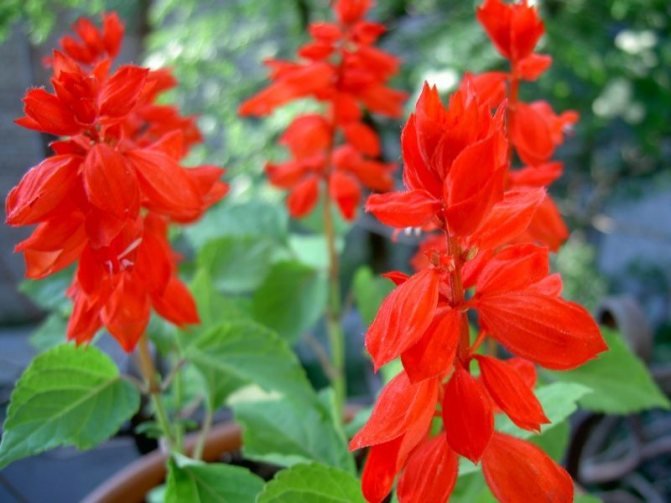

The height of annuals can vary from 25 to 70 cm, and perennials - from 120 to 130 cm.Only the hard work of breeders has made it possible to highlight the colors of light white, lilac, dark purple, pinkish and red tones.
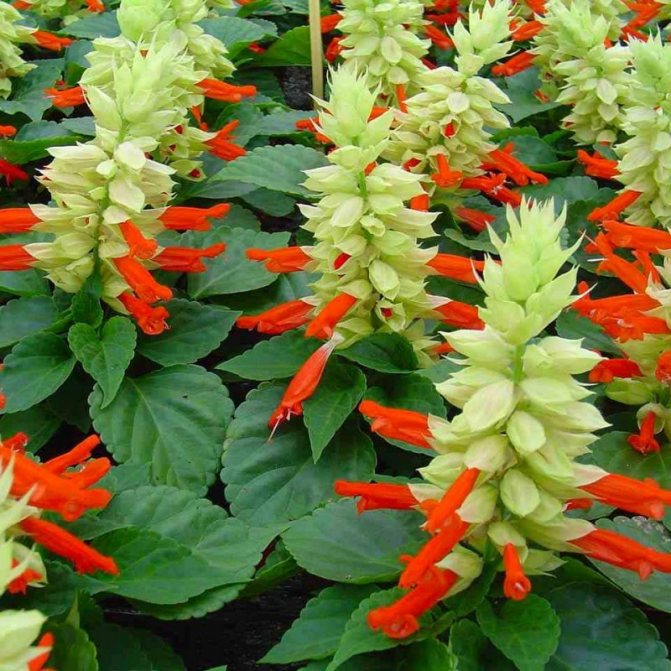

The stem is erect and tetrahedral, decorated with whole or pinnately dissected leaves, arranged in pairs, opposite each other.
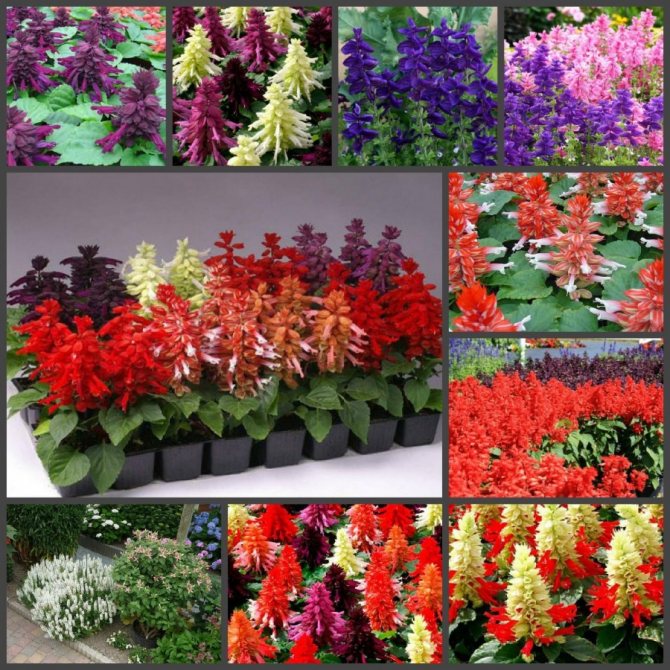

The leaf plate is lighter at the bottom than at the top. Spikelets, from 10 to 25 cm, are located at the top of the stem and form panicles or acquire a whorled shape.


After wilting, four nuts remain, containing seeds inside. Such buds ripen for a month and a half. For five years, they can be used for planting. For this reason, growing salvia from seed is as easy as shelling pears.
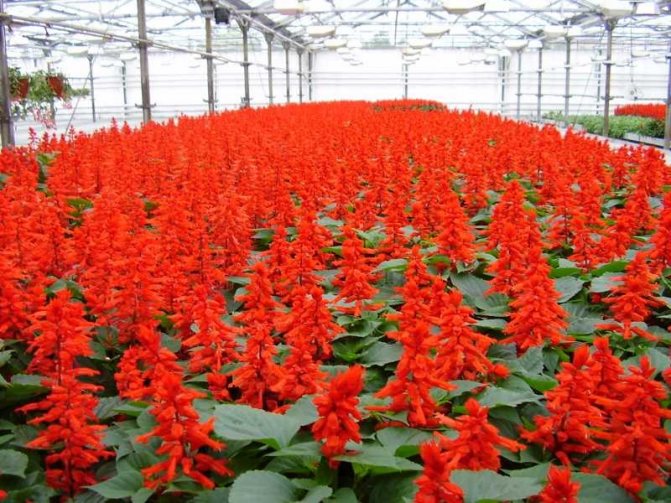

Structure
The beneficial properties of the plant are due to its extremely rich biochemical composition. A huge amount of vitamins and minerals make salvia an indispensable tool in the treatment of many ailments. The composition includes the following components:
- flavonoids, alkaloids;
- a large amount of tannins;
- fatty acids, essential oils;
- vitamins of group A, E, K;
- trace elements - magnesium, phosphorus, copper, zinc, selenium.
The greatest amount of nutrients is endowed with sage seeds. This medicinal material is used for the preparation of decoctions, tinctures, teas.
How to care?
Simple enough: water, feed, weed and loosen the soil in time. Watering is carried out when the soil becomes very dry in the evening.
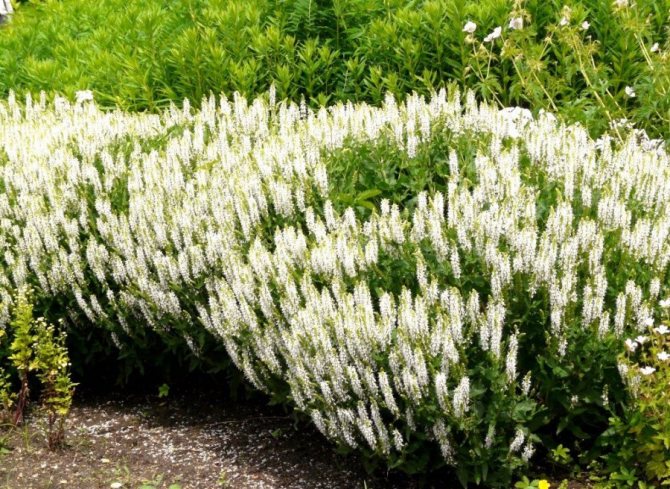

With an excess of liquid, rotting of the root structure is possible. They are fed twice a season with the addition of mineral biofertilizers.


Caring for perennial salvia is a little more difficult, since it requires formative pruning. It gives bushiness and protects the shoots from exposure and stretching. With the beginning of wintering, do not forget to trim the bush a little, removing unnecessary old stems.


Possible problems with seedlings and their solutions
Salvians are practically not susceptible to any diseases. Insects and slugs cause harm, which can be successfully dealt with using folk methods. Often, when growing seedlings, flower growers are faced with some unpleasant situations:
- Shoots do not appear for a long time... This situation can be observed if the swollen seeds were nevertheless overdried. It is best to sow again, since if the previous seeds sprout, the sprouts will not be completely healthy.
- The sprouts stand in their hats for a long time. Seed skins remain on plants for a long time if the seed material is not of a quality. Seedlings should be slightly moistened and with a toothpick help get rid of the seed coat. Then the seedlings are fed with complex microelements.
- Flowering is delayed or completely absent... If the plant has pale foliage, and the stems are very elongated, it means the whole thing is a lack of light. Salvias are quite demanding about this: no light - no color. If the problem is noticed at the beginning of summer, then you can try to make a transplant to a more sunny area. If the bush develops normally, the color is natural, saturated, and there are few or no buds at all, it means that the salvia is simply fattening from an excess of nitrogen. In this case, it is sprayed with superphosphate.
Collection of raw materials
Sage is harvested twice a season. The first collection takes place at the beginning of June. It is at this time that essential oil accumulates in the leaves. Sage is harvested for the second time in September. The herb is dried in the open air by spreading it on a cloth or paper in a thin layer.
Drying can be carried out in an oven or in an electric dryer at a temperature of + 30-35 ° C. At higher temperatures, essential oils volatilize. Raw materials retain their useful properties for one and a half years.Store the harvested grass in canvas or paper bags.
Contraindications to the use of sage
The use of sage for medicinal purposes is allowed only after consultation with a specialist, especially when it comes to taking medications inside. It should not be forgotten that sage treatment is not a panacea for all diseases, the plant has quite a few contraindications, which should include:
- individual intolerance to its individual components;
- pregnancy and breastfeeding of infants;
- age up to five years;
- sharp nephritis;
- diseases of the nervous system;
- hypothyroidism;
- uterine fibroids;
- polycystic ovary disease;
- endometriosis.
With prolonged use of sage-based drugs, some disorders of the nervous system, irritation of the mucous membranes may occur.
Planting salvia in the ground
It is better to choose the soil for sowing salvia light, permeable, with a lot of sand. It should also contain lime and humus.
Almost all Salvians love sunny places. Only a few species can grow in partial shade (eg, glutinous salvia). The place should be sheltered from the wind.
Seedlings are transplanted into open ground after the threat of night frosts has passed. As a rule, in the south it is May, in the central part of Russia it is mid-May, in the northern regions it is early June.
Salvia bushes are planted in small holes at a distance of 25-30 cm from each other. It is advisable to first add a handful of humus to each hole.
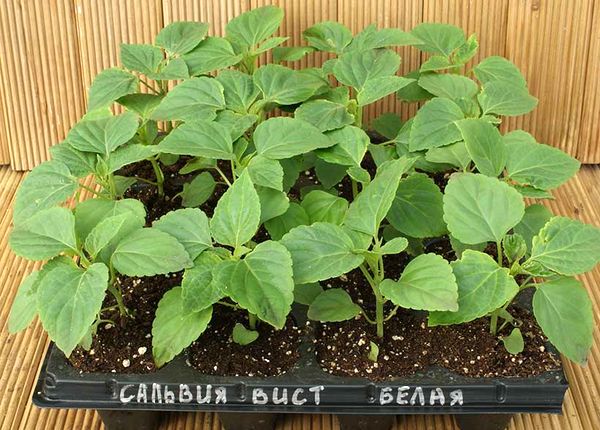

Now read:
- Salvia
- When to sow marigolds for seedlings in 2019. When…
- What to plant for seedlings in March
- How and when to plant zucchini for seedlings and in the open ...
- Growing lobelia from seeds at home. ...
Care features
In the hot summer, salvias need abundant watering, the rest of the time they need a little water. It is best to use a drip system. It is desirable to carry out the procedure in the evening.
The next day after watering, it is recommended to loosen the soil. Top dressing is usually carried out twice a season. This is done during the period of growing seedlings, and at the time of bud formation.
Growing perennial salvia is somewhat more difficult. It requires pruning and bush shaping. This is done in order to stimulate the regrowth of new shoots.
Usually, mass flowering begins in June, and continues until frost in the autumn months.
But different types of this plant have their own characteristics of flower formation. For some, the formation of flowers occurs twice per season. This is the characteristic of forest salvia. After it finishes its first flowering, its stems are pruned and after they regrow in late summer, flowers reappear. Fertilizing is recommended for such a plant.
Wintering of perennial salvia
Before the winter cold, the stems are cut in such a way that 10-12 centimeters above the ground remain, the lower leaves are removed.
In the northern regions, perennial salvia should be dug out of the ground with the onset of cold weather and stored in a bright room in boxes with earth. The temperature must be above 0ºC.
What is salvia sick and what insects are dangerous to her
As a rule, salvia reliably resists disease, and insect pests are reluctant to use this plant. But slugs and snails can devour the delicate foliage, and sometimes thrips, ticks, aphids, whiteflies precipitate it.
To remove slugs and snails, a mechanical method is used, collecting them by hand or laying out the bait in traps. These pests can be lured into containers with beer or sweet fruit juice.
Sage-based medicines: infusion
To prepare the infusion, you will need one part of dry raw material, which is poured over with ten parts of boiled warm water. You can take one part of fresh, previously well-washed and crushed leaves and fill them with five parts of water. The leaves should be infused for at least two hours.Such a composition can be used as a disinfectant and anti-inflammatory agent for lotions, rinses, compresses, etc.
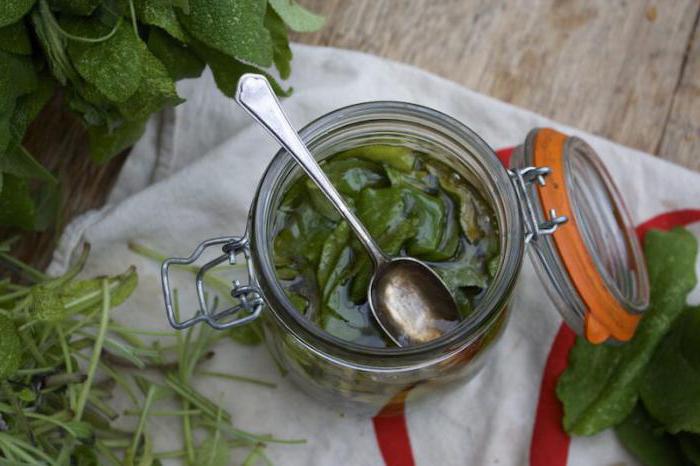

Wintering
There are two ways to ensure the wintering of sage:
- In the southern regions of Russia, it is possible to leave roots in the ground. But it is necessary to cover the cut flower with a film or bottle. This method of ensuring safety is relevant if the air temperature does not drop below -10.
- In the rest of the country, the root is dug up. It must be rinsed and residual soil removed. You also need to prepare a box in which the flower will be stored. It is recommended to use sawdust or mulch for preservation.
Expert opinion
Chernyaeva Tatiana Dmitrievna
He is madly in love with gardening and grows only organic vegetables.
Ask a Question
It is important that during storage of the flower a constant temperature (5 - 7 degrees) and air humidity are provided. It is necessary to check the condition of the roots once a month. If necessary, they need to be irrigated with a spray bottle.
Dosage forms
The pharmacy chain sells fees with sage, herbal raw materials, packaged in filter bags. The components are found in tablets and cough syrups. Essential oil of clary sage is produced, it is used for inhalation, for gargling. It is necessary to strictly adhere to the instructions, in a high concentration of resins and esters can cause burns.
Alcohol tincture is safer, it has a low concentration of components. It is used for the treatment of dental, ENT diseases, in gynecology, for the treatment of skin inflammatory processes, in cosmetology.
Floury
Tall bush up to 1 meter with a straight stem and large, large leaves. The number of spikelets can be up to 28 pcs. The beginning of flowering is mid-August, the end is late autumn.


Mediterranean group
- frost-resistant;
- loose soil, fertilizing with mineral fertilizers.
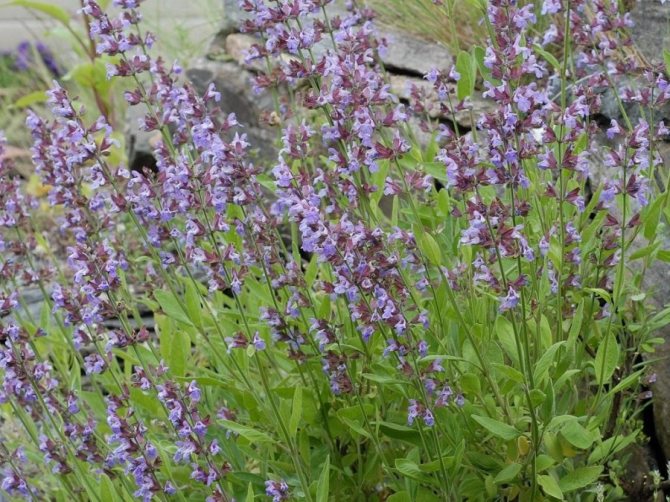

Methods of using harvested raw materials
The application depends on the disease. Inside use the infusion. To cook it, 1 tbsp. l. crushed raw materials are poured into a bowl and 1 glass of boiling water is poured into it. The liquid is infused for 1 hour, and then filtered through cheesecloth. Drinking the infusion is recommended three times a day, 100 ml 20 minutes before meals.
In the treatment of hemorrhoids, enemas with a concentrated infusion of salvia are used. 3 tbsp. l. dry crushed raw materials are poured with 100 ml of boiling water and the liquid is infused for 1 hour, wrapping the container with a blanket. The finished infusion is diluted with 1 liter of warm water.
Salvia oak (Salvia nemorosa)
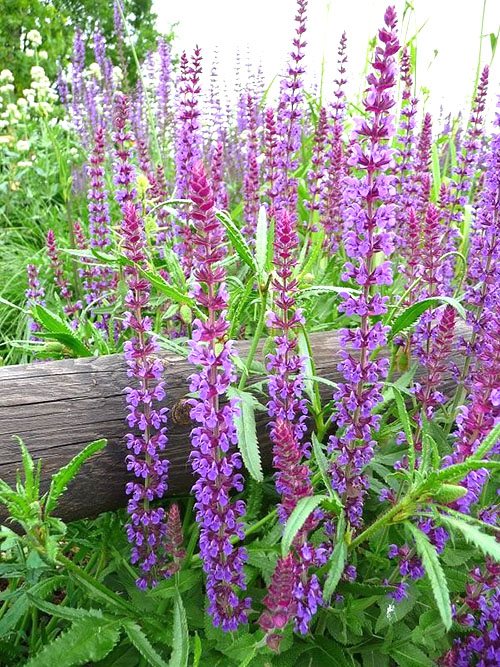

The sage species growing in the zone of the Russian forest-steppe has powerful stems up to 30-60 cm high and dense, candle-like inflorescences reaching 40 cm in length. Both corollas and large bracts are purple or azure in color.
If hairs are visible on the stems, then the pointed long leaves of Salvia Oakravna are completely smooth with teeth along the edges. The decorativeness of the plant lasts from mid-summer to mid-September.
Promotion of health in general and especially for women
Application for menopause
Especially often, sage herb is used to facilitate the course of the climacteric period, when the body undergoes physiological changes caused by the restructuring of the hormonal balance. One of the main signs characteristic of this period are hot flashes, lack of sleep, profuse sweating (especially at night), headaches, tachycardia, etc.


Sage relieves menopause symptoms
It has been clinically proven that an aqueous extract of fresh leaves of the plant actively copes with the problem of perspiration, is able to eliminate hot flashes.
Sage for infertility
The results of modern research successfully prove that the problem of infertility can be treated using the plant. The natural hormones of the herb are similar in composition to estrogens, and therefore can help to increase female fertility.
Doctors strongly recommend starting the treatment process after the end of menstruation (from 5 to 15 days). When starting treatment, it is important to remember that therapeutic actions with sage are not compatible with the intake of hormonal drugs... After going through several stages of herbal medicine, there is a need for a qualified examination (ultrasound) to describe the general condition of the body.


Sage fights female infertility, but drug therapy is incompatible with this plant
The course of therapy is carried out for no more than three months. Re-treatment, if necessary, is carried out after 30 days.
Stop taking sage if you experience any side effects. It is important to consult a specialist before starting fertility treatment.
Sage during menstruation and lactation
The sage herb, photo and description, and the medicinal properties of which are indicated above, has a negative effect on the production of breast milk. Given this fact, it is important to understand the main purpose of taking the plant.
This medicinal material is also able to restore the regularity of menstrual cycles, reduce pain during this period.

